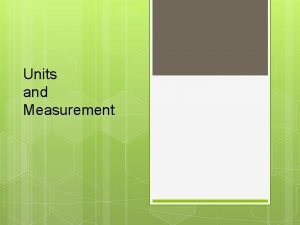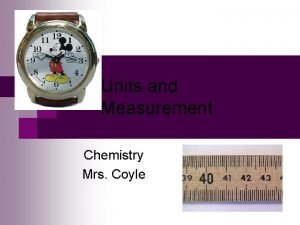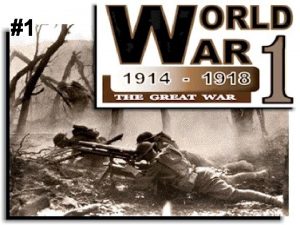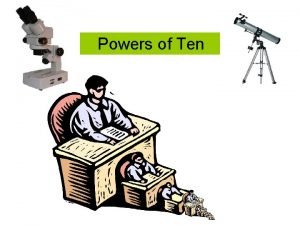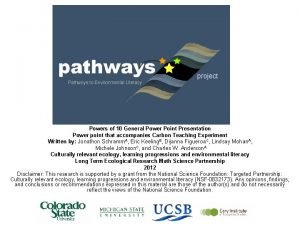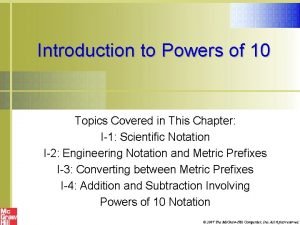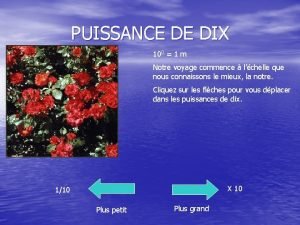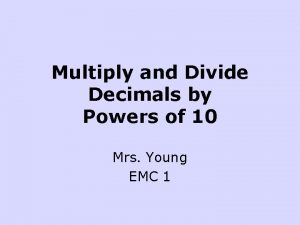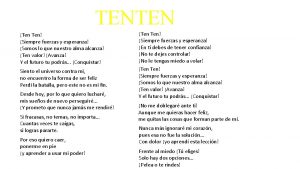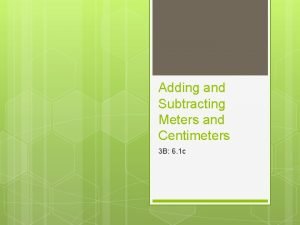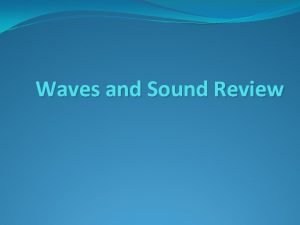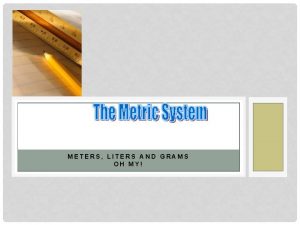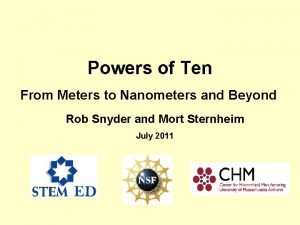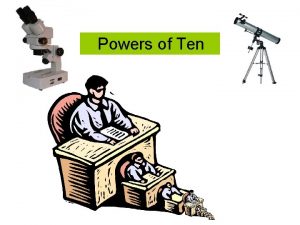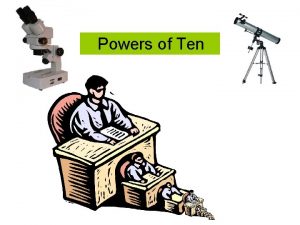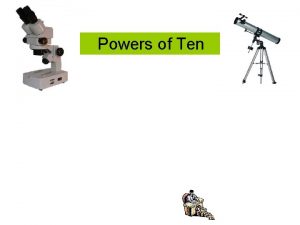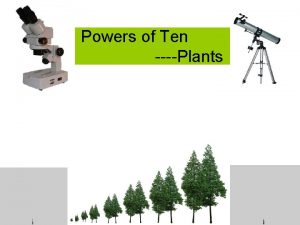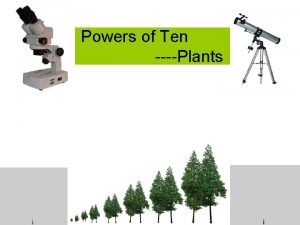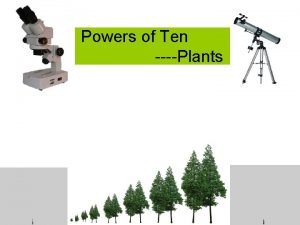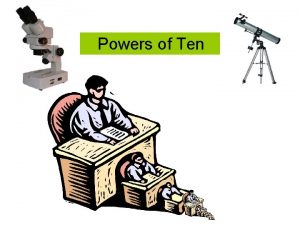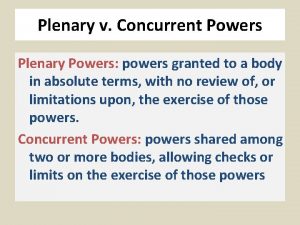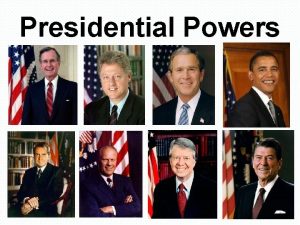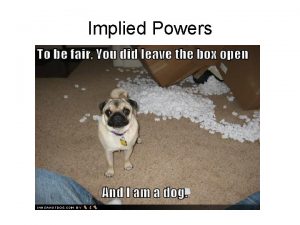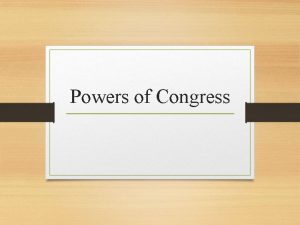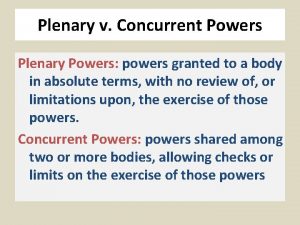Powers of Ten From Meters to Nanometers and




















- Slides: 20

Powers of Ten From Meters to Nanometers and Beyond Rob Snyder STEM Education Institute

The classic Powers of Ten movie narrated by Phillip Morrison reveals the range of size of structures in our universe – From the subatomic to the galactic. http: //www. eamesoffice. com/the-work/powers-of-ten/

Going up the Power of Ten Scale seems to capture the imagination of many students. • They have more experiences observing and making measurements of large structures. • Viewing objects like the sun, moon and stars may make them curious about very large objects and distances. • Movies, Videos, about journeys in space, etc. have helped students visualize large values for structures , distances and time.

Students might be curious about the speed of light if they learned that: Earth’s average orbital radius is 1. 5 x 1011 meters. It takes 5 x 102 seconds for sunlight to each Earth.

The challenge is to have them learn through observation that dimensions of wavelengths of visible light range from 3. 80 x 10 -7 m to 7. 50 x 10 -7 m.

The Nano. Sense project from 2004 to 2008 developed four nanoscale science curriculum units that are available at: http: //nanosense. sri. com/index. html. • • Size Matters: Introduction to Nanoscience Clear Sunscreen: How Light Interacts with Matter Clean Energy: Converting Light into Electricity Fine Filters: Filtering Solutions for Clean Water

In the “Size Matter” Unit, the Nano. Sense project suggested that there are prerequisite knowledge and skills that contribute to an understanding of the nanoscale dimension that include: • Familiarity with atoms, molecules and cell • Knowledge of basic units of the metric system and prefixes • Ability to manipulate exponential and scientific notation Most of the lessons in this unit rely heavily on comparing images of structures or the dimensions of those structures.

The goal of today’s activity is to guide students toward an understanding of nanoscale dimensions by: • Making a number of measurements using metersticks, magnifiers, microscopes and spectrometers so students can make observations and generate their own data. • Using scientific notation to compare the measurements they have made with the dimensions of very small structures. We also wanted to provide an activity that is appropriate for the middle school grades.

A Powers of Ten Data Table can be used to enter progressively smaller measurements or calculations The measurement Meters Centimeters Nanometers X 100 X 102 X 109 The challenge is to determine in which row measurement data should be recorded to that the dimensions are progressively smaller from the top to the bottom of the data table.

Common items and measurement tools can be used to initiate a process of going down a Powers of Ten scale.

Magnifiers help obtain the last significant digit in a measurement. The number of significant figures in a measurement, such as 2. 531, is equal to the number of digits that are known with some degree of confidence (2, 5, and 3) plus the last digit (1), which is an estimate or approximation. As we improve the sensitivity of the equipment used to make a measurement, the number of significant figures increases

A USB microscope put a magnified image of openings in coffee filters onto a computer screen.

How might a ruler be used to calibrate the magnification power of the USB microscope?

Spectrometers can be used to add more data. Wavelengths of visible light approach the nanoscale realm.

Simulating a Typical Classroom Setup A classroom may have only 3 USB microscope stations and 3 spectrometer stations. All of the student groups could begin the activity by answering a few warmup questions and making measurements with rulers and magnifiers. Each group could then move to either a microscope station or a spectrometer station as they become available.

The activity document also includes descriptions of categories of filters with openings smaller than wavelengths of light. Students use this information to continue make data entries. http: //www. sciencedaily. com/releases/2008/02/080222095403. htm

The filters described in the document can be used to filter progressively smaller structures such as bacteria, viruses and ions.

How do we generate images of structures with nanoscale dimensions? Tomorrow, you will build a model that simulates measurements made with a device called an Atomic Force Microscope. .

Atomic and ionic radii data can be used to extend data entries beyond the nanoscale. A picometer (pm) = 1 x 10 -12 meters 152 picometers = 152 x 1012 meters = 1. 52 x 1010 meters Source: http: //www. chem 1. com/acad/webtext/atoms/atpt-6. html#SIZE

A Few Questions • What can be added to the sequence of activities to more effectively develop a nanoscale perspective? • What skills and perspectives developed during this activity support the study of other STEM topics?
 Nanometers symbol
Nanometers symbol Nanometers symbol
Nanometers symbol Nanometers symbol
Nanometers symbol The central powers ww1
The central powers ww1 What is the difference between expressed and implied powers
What is the difference between expressed and implied powers Was the united states on the axis powers or allied powers?
Was the united states on the axis powers or allied powers? What's the difference between enumerated and implied powers
What's the difference between enumerated and implied powers Implied power
Implied power Difference between delegated concurrent and reserved powers
Difference between delegated concurrent and reserved powers Congress informal powers
Congress informal powers Scaling by powers of ten
Scaling by powers of ten Scaling by powers of ten
Scaling by powers of ten Powers of 10 chart prefixes
Powers of 10 chart prefixes Powers of ten
Powers of ten How to multiply decimals by powers of 10
How to multiply decimals by powers of 10 Twenty past two
Twenty past two Ten ten siempre fuerzas y esperanza
Ten ten siempre fuerzas y esperanza Amia 10 x 10
Amia 10 x 10 How to add meters and centimeters
How to add meters and centimeters Three waves a b and c travel 12 meters in 2.0 seconds
Three waves a b and c travel 12 meters in 2.0 seconds Writing meters liters and grams
Writing meters liters and grams
